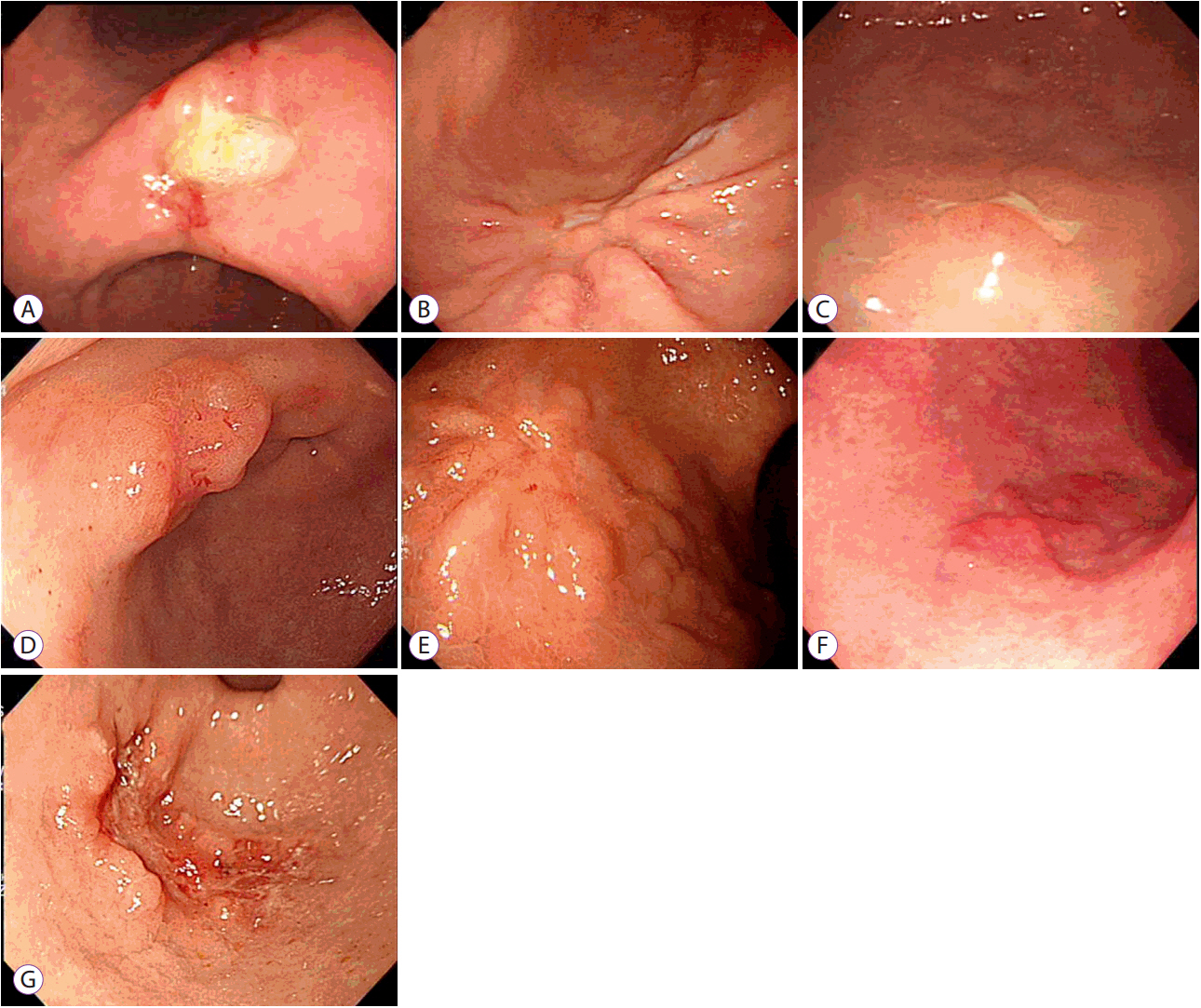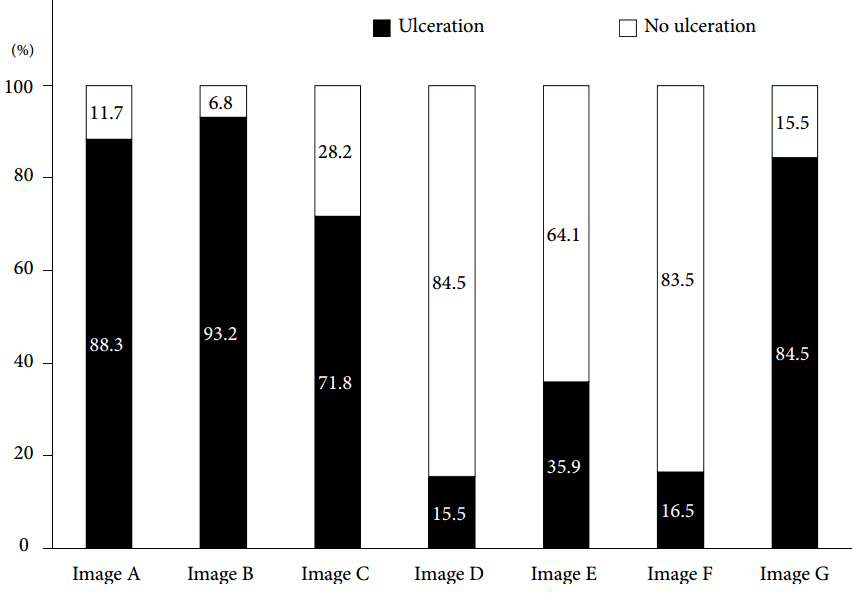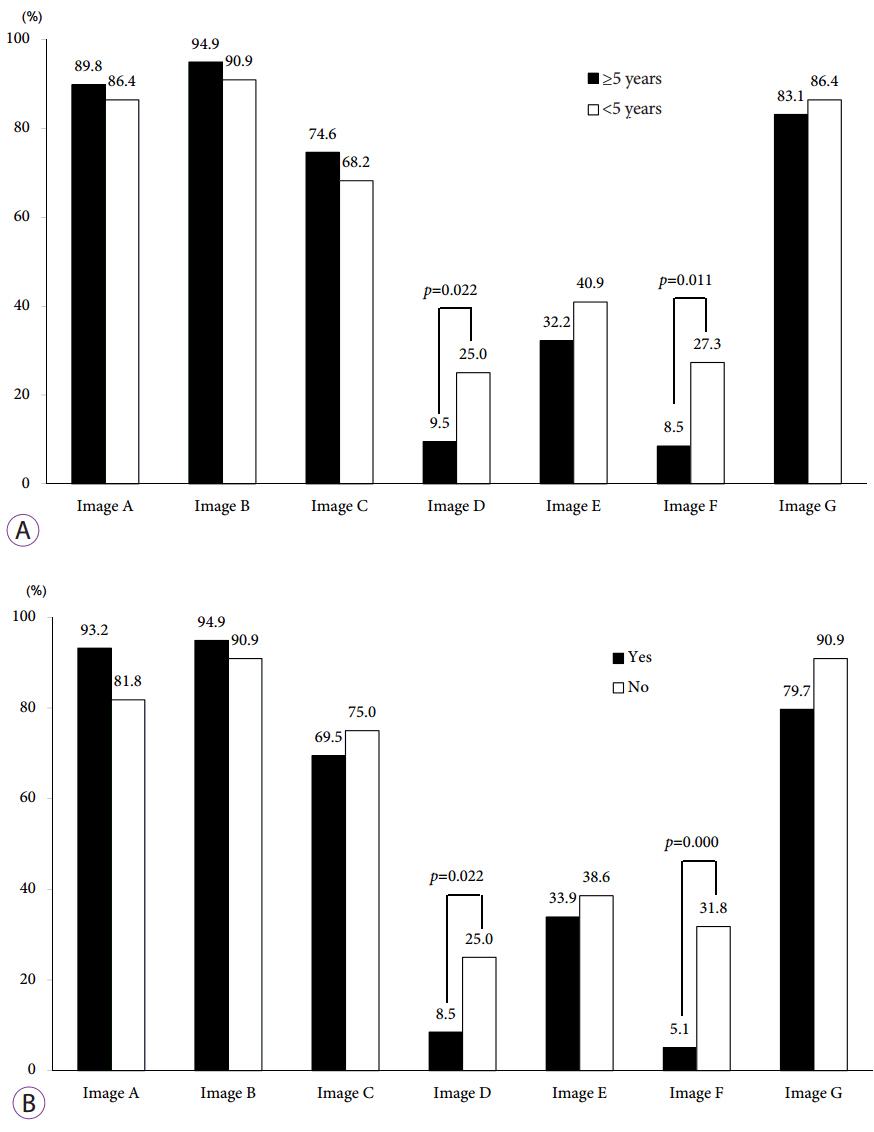Can Endoscopic Ulcerations in Early Gastric Cancer Be Clearly Defined before Endoscopic Resection? A Survey among Endoscopists
- Affiliations
-
- 1Division of Gastroenterology, Department of Internal Medicine, Incheon St. Mary's Hospital, College of Medicine, The Catholic University of Korea, Incheon, Korea. gastro@catholic.ac.kr
- KMID: 2394747
- DOI: http://doi.org/10.5946/ce.2016.143
Abstract
- BACKGROUND/AIMS
Early gastric cancer (EGC) with ulcerations can be treated via endoscopic resection (ER) when it is differentiated pathologically, limited to the mucosa, and <3 cm in diameter. The presence of ulceration is a key factor in deciding treatment strategies and is usually diagnosed during endoscopic examination. The aim of this study was to evaluate whether ulcerations in EGC can be clearly defined among endoscopists and which factors are related to the differences.
METHODS
A survey questionnaire, composed of demographic features and endoscopic images of seven patients with EGC, was presented to the endoscopists via e-mail. The endoscopists were asked whether such patients have ulcerations in the lesions.
RESULTS
The questionnaires were e-mailed to 197 endoscopists, and 103 doctors replied. The presence of an endoscopic ulceration was defined differently among the endoscopists, depending on the duration of endoscopic practice and the experience of endoscopic submucosal dissection. The differences were especially high in the lesions without mucosal breaks and converging folds, which were expected to be viewed as non-ulcerative.
CONCLUSIONS
Before ER, endoscopic ulcerations in EGC must be reviewed by experienced endoscopists to reduce overestimations, and adequate educational programs for trainees should be established.
Figure
Cited by 5 articles
-
Endoscopic Factors that Can Predict Histological Ulcerations in Early Gastric Cancers
Jaesin Lee, Byung-Wook Kim, Cheal Wung Huh, Joon Sung Kim, Lee-So Maeng
Clin Endosc. 2020;53(3):328-333. doi: 10.5946/ce.2019.133.What is the Most Precise Endoscopic Finding for Predicting the Clinicopathological Behaviors in Ulcerative Early Gastric Cancer?
Youngdae Kim
Clin Endosc. 2020;53(3):249-250. doi: 10.5946/ce.2020.107.Risk Factors for Lymph Node Metastasis in Undifferentiated-Type Gastric Carcinoma
Myeong-Cherl Kook
Clin Endosc. 2019;52(1):15-20. doi: 10.5946/ce.2018.193.Identification of Ulceration in Early Gastric Cancer before Resection is Not Easy: Need for a New Guideline for Endoscopic Submucosal Dissection Indication Based on Endoscopic Image
Hang Lak Lee
Clin Endosc. 2017;50(5):410-411. doi: 10.5946/ce.2017.140.A standardized pathology report for gastric cancer: 2nd edition
Young Soo Park, Myeong-Cherl Kook, Baek-hui Kim, Hye Seung Lee, Dong-Wook Kang, Mi-Jin Gu, Ok Ran Shin, Younghee Choi, Wonae Lee, Hyunki Kim, In Hye Song, Kyoung-Mee Kim, Hee Sung Kim, Guhyun Kang, Do Youn Park, So-Young Jin, Joon Mee Kim, Yoon Jung Choi, Hee Kyung Chang, Soomin Ahn, Mee Soo Chang, Song-Hee Han, Yoonjin Kwak, An Na Seo, Sung Hak Lee, Mee-Yon Cho
J Pathol Transl Med. 2023;57(1):1-27. doi: 10.4132/jptm.2022.12.23.
Reference
-
1. Carter KJ, Schaffer HA, Ritchie WP Jr. Early gastric cancer. Ann Surg. 1984; 199:604–609.
Article2. Everett SM, Axon AT. Early gastric cancer in Europe. Gut. 1997; 41:142–150.
Article3. Chung IK, Lee JH, Lee SH, et al. Therapeutic outcomes in 1000 cases of endoscopic submucosal dissection for early gastric neoplasms: Korean ESD study group multicenter study. Gastrointest Endosc. 2009; 69:1228–1235.
Article4. Isomoto H, Shikuwa S, Yamaguchi N, et al. Endoscopic submucosal dissection for early gastric cancer: a large-scale feasibility study. Gut. 2009; 58:331–336.
Article5. Gotoda T, Yanagisawa A, Sasako M, et al. Incidence of lymph node metastasis from early gastric cancer: estimation with a large number of cases at two large centers. Gastric Cancer. 2000; 3:219–225.
Article6. Japanese Gastric Cancer Association. Japanese gastric cancer treatment guidelines 2010 (ver. 3). Gastric Cancer. 2011; 14:113–123.7. Kim DY, Hong SJ, Cho GS, et al. Long-term efficacy of endoscopic submucosal dissection compared with surgery for early gastric cancer: a retrospective cohort study. Gut Liver. 2014; 8:519–525.
Article8. Chiu PW, Teoh AY, To KF, et al. Endoscopic submucosal dissection (ESD) compared with gastrectomy for treatment of early gastric neoplasia: a retrospective cohort study. Surg Endosc. 2012; 26:3584–3591.
Article9. Park CH, Lee H, Kim DW, et al. Clinical safety of endoscopic submucosal dissection compared with surgery in elderly patients with early gastric cancer: a propensity-matched analysis. Gastrointest Endosc. 2014; 80:599–609.10. Choi JH, Kim ES, Lee YJ, et al. Comparison of quality of life and worry of cancer recurrence between endoscopic and surgical treatment for early gastric cancer. Gastrointest Endosc. 2015; 82:299–307.
Article11. Sakita T, Oguro Y, Takasu S, Fukutomi H, Miwa T. Observations on the healing of ulcerations in early gastric cancer. The life cycle of the malignant ulcer. Gastroenterology. 1971; 60:835–839.12. Ojima T, Takifuji K, Nakamura M, et al. Complications of endoscopic submucosal dissection for gastric noninvasive neoplasia: an analysis of 647 lesions. Surg Laparosc Endosc Percutan Tech. 2014; 24:370–374.13. Miyahara K, Iwakiri R, Shimoda R, et al. Perforation and postoperative bleeding of endoscopic submucosal dissection in gastric tumors: analysis of 1190 lesions in low- and high-volume centers in Saga, Japan. Digestion. 2012; 86:273–280.
Article14. Imagawa A, Okada H, Kawahara Y, et al. Endoscopic submucosal dissection for early gastric cancer: results and degrees of technical difficulty as well as success. Endoscopy. 2006; 38:987–990.
Article15. Yeomans ND, Naesdal J. Systematic review: ulcer definition in NSAID ulcer prevention trials. Aliment Pharmacol Ther. 2008; 27:465–472.
Article16. Faulx AL, Vela S, Das A, et al. The changing landscape of practice patterns regarding unsedated endoscopy and propofol use: a national Web survey. Gastrointest Endosc. 2005; 62:9–15.
Article17. Yusuf TE, Harewood GC, Clain JE, Levy MJ. International survey of knowledge of indications for EUS. Gastrointest Endosc. 2006; 63:107–111.
Article
- Full Text Links
- Actions
-
Cited
- CITED
-
- Close
- Share
- Similar articles
-
- Endoscopic Resection of Undifferentiated Early Gastric Cancer
- Endoscopic Treatment for Early Gastric Cancer
- Endoscopic Factors that Can Predict Histological Ulcerations in Early Gastric Cancers
- Endoscopic Resection of Early Gastric Cancer
- Endoscopic Resection of Early Gastric Cancer in Korea: Recent Results and Future Directions




